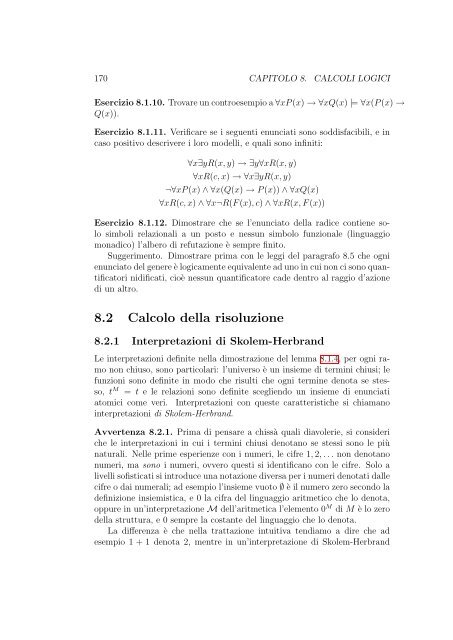Logica Matematica Corso di Laurea in Informatica ... - Mbox.dmi.unict.it
Logica Matematica Corso di Laurea in Informatica ... - Mbox.dmi.unict.it
Logica Matematica Corso di Laurea in Informatica ... - Mbox.dmi.unict.it
You also want an ePaper? Increase the reach of your titles
YUMPU automatically turns print PDFs into web optimized ePapers that Google loves.
170 CAPITOLO 8. CALCOLI LOGICI<br />
Esercizio 8.1.10. Trovare un controesempio a ∀xP (x) → ∀xQ(x) |= ∀x(P (x) →<br />
Q(x)).<br />
Esercizio 8.1.11. Verificare se i seguenti enunciati sono sod<strong>di</strong>sfacibili, e <strong>in</strong><br />
caso pos<strong>it</strong>ivo descrivere i loro modelli, e quali sono <strong>in</strong>f<strong>in</strong><strong>it</strong>i:<br />
∀x∃yR(x, y) → ∃y∀xR(x, y)<br />
∀xR(c, x) → ∀x∃yR(x, y)<br />
¬∀xP (x) ∧ ∀x(Q(x) → P (x)) ∧ ∀xQ(x)<br />
∀xR(c, x) ∧ ∀x¬R(F (x), c) ∧ ∀xR(x, F (x))<br />
Esercizio 8.1.12. Dimostrare che se l’enunciato della ra<strong>di</strong>ce contiene solo<br />
simboli relazionali a un posto e nessun simbolo funzionale (l<strong>in</strong>guaggio<br />
mona<strong>di</strong>co) l’albero <strong>di</strong> refutazione è sempre f<strong>in</strong><strong>it</strong>o.<br />
Suggerimento. Dimostrare prima con le leggi del paragrafo 8.5 che ogni<br />
enunciato del genere è logicamente equivalente ad uno <strong>in</strong> cui non ci sono quantificatori<br />
ni<strong>di</strong>ficati, cioè nessun quantificatore cade dentro al raggio d’azione<br />
<strong>di</strong> un altro.<br />
8.2 Calcolo della risoluzione<br />
8.2.1 Interpretazioni <strong>di</strong> Skolem-Herbrand<br />
Le <strong>in</strong>terpretazioni def<strong>in</strong><strong>it</strong>e nella <strong>di</strong>mostrazione del lemma 8.1.4, per ogni ramo<br />
non chiuso, sono particolari: l’universo è un <strong>in</strong>sieme <strong>di</strong> term<strong>in</strong>i chiusi; le<br />
funzioni sono def<strong>in</strong><strong>it</strong>e <strong>in</strong> modo che risulti che ogni term<strong>in</strong>e denota se stesso,<br />
t M = t e le relazioni sono def<strong>in</strong><strong>it</strong>e scegliendo un <strong>in</strong>sieme <strong>di</strong> enunciati<br />
atomici come veri. Interpretazioni con queste caratteristiche si chiamano<br />
<strong>in</strong>terpretazioni <strong>di</strong> Skolem-Herbrand.<br />
Avvertenza 8.2.1. Prima <strong>di</strong> pensare a chissà quali <strong>di</strong>avolerie, si consideri<br />
che le <strong>in</strong>terpretazioni <strong>in</strong> cui i term<strong>in</strong>i chiusi denotano se stessi sono le più<br />
naturali. Nelle prime esperienze con i numeri, le cifre 1, 2, . . . non denotano<br />
numeri, ma sono i numeri, ovvero questi si identificano con le cifre. Solo a<br />
livelli sofisticati si <strong>in</strong>troduce una notazione <strong>di</strong>versa per i numeri denotati dalle<br />
cifre o dai numerali; ad esempio l’<strong>in</strong>sieme vuoto ∅ è il numero zero secondo la<br />
def<strong>in</strong>izione <strong>in</strong>siemistica, e 0 la cifra del l<strong>in</strong>guaggio ar<strong>it</strong>metico che lo denota,<br />
oppure <strong>in</strong> un’<strong>in</strong>terpretazione M dell’ar<strong>it</strong>metica l’elemento 0 M <strong>di</strong> M è lo zero<br />
della struttura, e 0 sempre la costante del l<strong>in</strong>guaggio che lo denota.<br />
La <strong>di</strong>fferenza è che nella trattazione <strong>in</strong>tu<strong>it</strong>iva ten<strong>di</strong>amo a <strong>di</strong>re che ad<br />
esempio 1 + 1 denota 2, mentre <strong>in</strong> un’<strong>in</strong>terpretazione <strong>di</strong> Skolem-Herbrand




![Introduzione ai sistemi Wiki [PDF] - Mbox.dmi.unict.it](https://img.yumpu.com/16413205/1/184x260/introduzione-ai-sistemi-wiki-pdf-mboxdmiunictit.jpg?quality=85)











